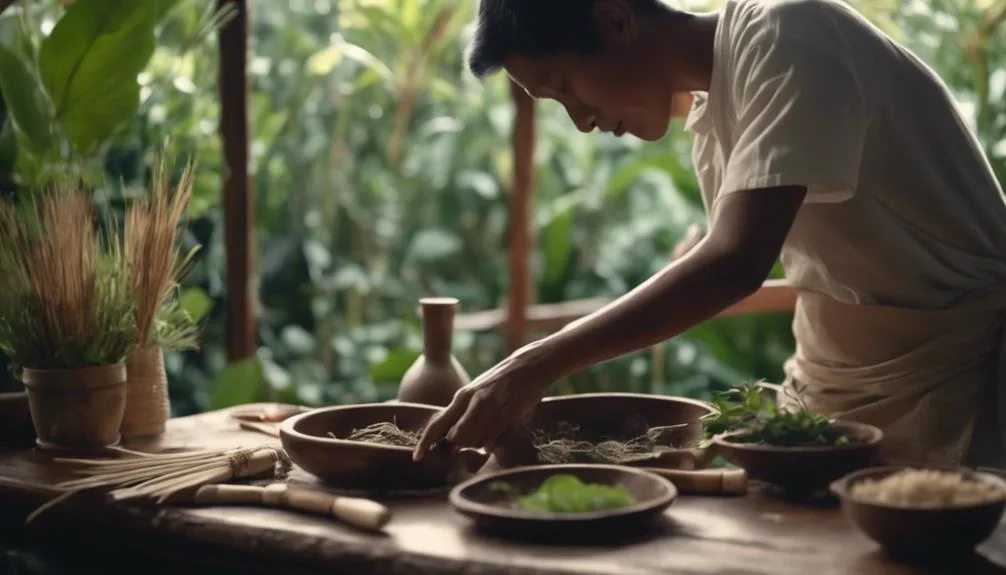Filipino Ancestral Beliefs and Mindfulness Integration
In the rich tapestry of life, Filipino ancestral beliefs and mindfulness practices offer a unique blend of spiritual nourishment and psychological well-being.
You might find it fascinating how concepts like Ginhawa weave together the physical, emotional, and spiritual realms, creating a holistic approach to health that scholars and practitioners have begun to explore more deeply.
As you consider the integration of these ancient practices with modern psychotherapy, think about the potential for transformative healing and growth.
This journey into the heart of Filipino mindfulness promises to uncover insights that could enrich not only personal well-being but also offer valuable lessons for community resilience and unity.
Key Takeaways
- Filipino ancestral wisdom combines spirituality, community, and nature for holistic well-being.
- Mindfulness practices, deeply rooted in Filipino culture, promote introspection and spiritual connection.
- Cultural traditions like harana and hilot integrate mindfulness into daily life and healing practices.
- Preserving and adapting ancestral mindfulness ensures its relevance for future generations and strengthens cultural identity.
Ancestral Wisdom Defined
Ancestral wisdom in Filipino culture encompasses a rich tapestry of traditional knowledge and practices, handed down through generations to guide and enrich the lives of individuals today. This indigenous knowledge, deeply rooted in the spiritual, cultural, and philosophical teachings of ancestors, serves a pivotal role in shaping daily life and mental health. It's a holistic approach that intertwines the wellbeing of the mind, body, and spirit, offering a unique perspective on living a balanced life.
In the context of mental health, ancestral wisdom provides a foundation for resilience and strength. By embracing the rituals, ceremonies, and storytelling that honor ancestors, individuals find a sense of connection to their past, grounding them in a community and tradition that transcends time. This connection fosters a deep understanding of self and community, crucial for mental wellbeing.
Moreover, integrating this wisdom into daily life encourages a harmonious relationship with the natural world, echoing the importance of environmental stewardship. It's a testament to the timeless relevance of indigenous knowledge in addressing contemporary challenges, ensuring that the legacy of ancestors continues to guide and inspire future generations. Through this lens, ancestral wisdom isn't just a relic of the past but a living, breathing aspect of Filipino identity, vital for holistic health and mindfulness.
The Role of Pagmumuni-muni
Within the rich tapestry of Filipino ancestral beliefs, pagmumuni-muni stands out as a key practice of introspection that fosters a profound connection with one's inner self and the spiritual realm. Rooted deeply in the culture, it's not merely about personal reflection, but a holistic approach to understanding one's place in the universe. This form of mindfulness, as studied and elucidated by scholars from the University of the Philippines, is a testament to the Filipino people's enduring relationship with their spiritual heritage.
Pagmumuni-muni involves a deliberate process of contemplating one's thoughts, emotions, and experiences. It's a journey towards inner peace and clarity, achieved through rituals, prayers, and meditation. This practice encourages you to align your actions with your core values, cultivating a harmonious relationship with nature and the cosmos.
Bayanihan: Community Mindfulness

Traditionally, Bayanihan exemplifies the Filipino ethos of community mindfulness, where neighbors invariably come together to support one another in times of need, fostering an environment of unity and cooperative spirit. This cultural practice, deeply ingrained in the Filipino consciousness, emphasizes communal unity and cooperation. It's not just about physical acts of moving houses or sharing resources; it's a manifestation of the deeper interconnectedness that defines human relationships within the community.
By engaging in Bayanihan, you're partaking in a tradition that not only strengthens community bonds but also nurtures mindfulness through shared responsibilities and mutual assistance. This collective effort underlines the significance of traditional values in modern applications, demonstrating how ancestral beliefs can guide contemporary living towards more cohesive and spiritually enriched communities.
As you immerse yourself in the practice of Bayanihan, you contribute to the collective well-being, fostering an atmosphere where spiritual growth and mindfulness practices flourish. This tradition teaches the importance of looking beyond the self, recognizing the value of harmonious relationships, and the power of community bonding in achieving a balanced and mindful life. Through Bayanihan, you're not just helping others; you're cultivating an environment where everyone grows together, embodying the essence of collective well-being and spiritual growth.
Nature and Spirituality Connected
You'll find that Filipino ancestral beliefs intertwine nature and spirituality, seeing the natural world not just as a setting, but as an active participant in spiritual life.
Indigenous practices, from making offerings at sacred shrines to conducting rituals in pristine natural locations, underscore the reverence for nature's role in connecting to the divine.
This holistic perspective highlights how ancestral spirits are honored through engagements with nature, revealing a profound spiritual significance attributed to the natural environment.
Spiritual Significance of Nature
Exploring the spiritual significance of nature reveals how indigenous Filipinos intricately wove the physical environment into their spiritual fabric, seeing mountains, trees, and water bodies not just as parts of the landscape but as vital participants in their sacred practices.
Nature reverence was deeply embedded in their worldview, establishing a profound spiritual connection with the earth. Sacred landscapes, including balete trees, mountains, and waterfalls, weren't merely scenic; they were sanctuaries for communication with ancestral spirits.
Despite the Spanish colonization's attempt to sever these ties by destroying indigenous worship sites, the enduring sacredness of natural locations signifies the resilience of these spiritual connections. The shamans' practices of healing and imparting wisdom through nature further underscore the inseparable bond between the physical and spiritual realms in Filipino ancestral beliefs.
Ancestral Practices in Nature
Building on the spiritual significance of nature, it's essential to understand how indigenous Filipinos seamlessly integrated ancestral practices within natural settings, revealing a profound connection between spirituality and the environment.
- Nature reverence, cultural heritage: Sacred sites like balete trees and mountains were venerated for spiritual connection.
- Spiritual connection, environmental conservation: These practices underscored the interconnectedness of physical and spiritual realms, fostering a sense of responsibility towards nature.
- Shamanic rituals, healing traditions: Shamans employed natural elements for healing and to maintain balance, demonstrating deep ecological knowledge.
- Impact of colonization: The destruction of sacred sites by Spanish colonization challenged the preservation of these ancestral practices, yet they remain integral to Filipino cultural heritage.
These elements offer a holistic view on the enduring legacy of nature in Filipino spirituality and cultural identity.
Anito Guidance in Modern Times

In modern Filipino spirituality, anito guidance actively involves seeking insights and protection from ancestral spirits, reflecting a deep connection to cultural heritage and traditional beliefs. This process isn't just about preserving the past; it's a vibrant part of the present, where cultural adaptation allows modern practitioners to weave ancestral wisdom into the fabric of their daily lives. Through rituals like pag-anito, they've creatively adapted these practices to fit contemporary contexts, ensuring that the spiritual connection with ancestral spirits remains strong and relevant.
This spiritual connection isn't merely symbolic. It has practical applications in decision-making and healing practices, demonstrating a holistic approach to life's challenges. By consulting the anito, modern Filipinos engage in a form of mindfulness that's deeply rooted in their cultural identity. This integration highlights the importance of ancestral spirits in providing guidance and support, underlining the belief in a spiritual interconnectedness that transcends time.
The fusion of traditional beliefs with modern mindfulness practices through anito guidance offers a unique perspective on spiritual well-being. It emphasizes the value of ancestral wisdom in navigating the complexities of modern life, ensuring that the legacy of Filipino ancestral beliefs continues to enrich the present and future generations.
Harana: Mindful Expressions of Love
You'll find Harana's historical roots deeply embedded in the rich tapestry of Filipino courtship traditions, serving as a bridge to understanding how mindfulness is woven into serenading practices.
This form of expression not only showcases emotional vulnerability but also establishes a profound emotional impact on listeners, reflecting a culture that values sincerity and depth in relationships.
Through an examination of Harana, you gain insights into the intricate ways Filipinos have historically intertwined mindfulness with expressions of love, highlighting the practice's role in fostering genuine connections.
Harana's Historical Roots
Harana, a traditional Filipino serenade, embodies the artful expression of love and admiration, tracing its roots back to the Spanish colonial era. This practice highlights a unique blend of cultural influences, showcasing the depth of Filipino romantic tradition through music.
- Spanish influence: Harana's origins are deeply intertwined with Spain's cultural imprint on the Philippines, merging Western musical styles with local expressions.
- Musical fusion: The integration of Filipino and Western melodies creates a distinct sound that's both enchanting and nostalgic.
- Romantic tradition: It stands as a testament to the enduring Filipino values of courtship and respect.
- Emotional expression: Through heartfelt songs, Harana offers a window into the sincere and respectful way lovers communicate their deepest feelings.
In essence, Harana not only celebrates love but also serves as a bridge connecting the past to the present, fostering a deeper appreciation for Filipino heritage and emotional well-being.
Mindfulness in Serenading Practices
Delving into the practice of Harana, one discovers a profound mindfulness embedded in each serenade, where emotions and intentions are conveyed with genuine sincerity and attention. This cultural ritual champions musical mindfulness, utilizing melodies, poetic lyrics, and heartfelt songs as vehicles for emotional serenading.
Harana isn't just about the music; it's a holistic expression of love, fostering deep serenade connections between the serenader and the recipient. The act requires vulnerability, encouraging participants to be fully present, respectful, and sincere.
Through this mindful engagement, Harana transcends mere performance, becoming a heartfelt process of sharing, understanding, and connecting, cementing its place as a cherished tradition that beautifully encapsulates the essence of emotional expression and connection.
Emotional Impact on Listeners
Exploring further into the cultural fabric of Harana, it's evident that this practice not only serves as a medium for serenaders to express their emotions but also profoundly impacts listeners, evoking a spectrum of emotional responses.
- Impactful emotions: Joy, nostalgia, longing, and tenderness are vividly experienced, enhancing emotional well-being.
- Cultural connections: Engages listeners in a deep, cultural tradition, fostering a sense of belonging and identity.
- Heartfelt serenades: The poetic lyrics and melodious tunes convey love and longing, resonating on a profound level.
- Mindful expression: Encourages mindfulness and vulnerability, strengthening emotional connections between individuals.
This holistic approach to understanding Harana emphasizes not just the serenade's role in expressing love, but also its significant emotional impact on listeners, bridging cultural gaps and forging deeper human connections.
Rituals for Inner Peace
Numerous rituals for inner peace in Filipino ancestral beliefs intricately weave offerings and communications with the spiritual realm to foster harmony and guidance. You'll find that these practices are deeply rooted in the culture's connection to the natural and spiritual worlds, reflecting an understanding that peace within oneself is intertwined with the harmony of the larger cosmos.
| Ritual Component | Description |
|---|---|
| Ancestral offerings | Items or food presented to ancestors' spirits, acknowledging their presence and seeking their protection. |
| Spiritual communication | Practices like pag-anito and pagdiwata, serving as dialogues with the spiritual realm for guidance. |
| Shamanic rituals | Performed by shamans to heal, protect, and maintain inner peace, utilizing their deep connection with spiritual entities. |
| Sacred sites | Locations like balete trees and mountains, considered potent for rituals aimed at inner peace and spiritual balance. |
| Nature veneration | Respect and offerings to nature spirits and guardian spirits, recognizing their influence on well-being and inner harmony. |
Understanding these components sheds light on the holistic and ethnographic aspects of Filipino ancestral beliefs, highlighting the intricate relationship between the self, the community, and the cosmos in achieving inner peace.
Mindfulness in Filipino Cuisine

Building on the understanding of rituals for inner peace, let's examine how mindfulness manifests in Filipino cuisine, where the preparation and enjoyment of food are deeply intertwined with cultural heritage and communal values. This culinary mindfulness isn't just about what's on the table; it's about the journey food takes from source to plate and the respect given to each component along the way.
Consider these aspects:
- Ingredient mindfulness, local sourcing: You're not just eating; you're partaking in a meal that honors the local environment, using fresh ingredients that reflect the Filipino landscape.
- Culinary traditions, attention to detail: Every dish tells a story, a testament to patience and precision, from the slow simmering of adobo to the careful preparation of kinilaw.
- Respecting natural flavors and textures: This approach ensures that the integrity of each ingredient is maintained, celebrating their inherent qualities rather than masking them.
- Connection to cultural heritage, community values: Meals are a communal affair, a time to reconnect with family, friends, and ancestors, embodying the values of togetherness and respect for the past.
In Filipino cuisine, mindfulness isn't a trend; it's a tradition, weaving together the fabric of cultural identity with each bite.
Healing Through Hilot Practices
Hilot, a traditional Filipino healing practice, intricately combines massage, herbal remedies, and spiritual rituals to address both physical and emotional imbalances. As you delve into this ancestral art, you're not just looking at a method of healing, but a deeply rooted philosophy that sees the body and spirit as interconnected. This holistic approach ensures that energy alignment and emotional wellness are not just goals but the very essence of the practice.
| Aspect | Impact on Individual | Emotional Evoke |
|---|---|---|
| Massage | Releases physical tension | Relief and comfort |
| Herbal Medicine | Detoxifies the body | Renewal |
| Spiritual Rituals | Harmonizes spirit | Peace and connection |
Practitioners, known as manghihilot, possess a profound understanding of the human body and spirit. They use their hands not only to diagnose and heal but to narrate a story of rebalancing and rejuvenation. Through their touch, prayers, and the use of natural elements like coconut oil and banana leaves, they guide individuals towards a state of wholeness.
In embracing hilot, you're not merely undergoing traditional healing; you're participating in a cultural legacy that emphasizes energy alignment and fosters emotional wellness. This age-old practice offers a pathway to understanding the depths of Filipino ancestral wisdom and its relevance in contemporary wellness.
Future of Ancestral Mindfulness

As we delve into the future of ancestral mindfulness, it's clear that preserving indigenous Filipino beliefs and practices is key to maintaining a strong cultural identity and enhancing overall well-being. The path forward involves:
- Preserving traditions through continued research and documentation of indigenous practices.
- Promoting cultural reconnection by creating platforms for modern Filipinos to engage with their ancestral heritage.
- Integrating ancestral mindfulness into educational curriculums to foster a deeper understanding and appreciation from a young age.
- Establishing collaborations between academics, practitioners, and local communities to ensure the sustainability of these practices.
This approach isn't just about looking back; it's about weaving ancestral wisdom into the fabric of contemporary life. The future hinges on a holistic understanding of how these practices contribute to mental and emotional health. By embracing educational integration, we not only honor our past but also enrich our present lives with meaning and purpose.
The key lies in recognizing the intrinsic value of these ancestral practices and ensuring they're passed on to future generations, thus nurturing a sense of belonging and identity rooted deeply in Filipino culture.
Frequently Asked Questions
What Were the Beliefs of the Ancient Filipinos?
You're exploring ancient Filipinos' beliefs, which deeply intertwined with nature worship, anito veneration, and community rituals. Their holistic view saw spirits in natural sites, guiding their ethnographic practices and shaping their communal and spiritual life.
What Are the Traditional Healing Techniques in the Philippines?
In the Philippines, traditional healing techniques include herbal remedies, Hilot massage, and Albularyo practices involving natural elements and rituals. These methods offer a holistic approach to health, deeply rooted in cultural heritage and knowledge.
What Is the Traditional Filipino Spirituality?
Traditional Filipino spirituality, deeply rooted in nature worship and community rituals, evolved under colonial influences. It's a rich tapestry where ancestral and nature spirits are revered, reflecting an ethnographic depth in spiritual practices.
What Are the Indigenous Beliefs and Practices in the Philippines?
You're exploring indigenous beliefs in the Philippines, focusing on nature spirits, community rituals, and ancestral veneration. These practices reveal a deep connection to the environment and the past, shaping a unique cultural identity.
Conclusion
As you journey through the tapestry of Filipino ancestral wisdom, it's clear that embracing Ginhawa isn't just about finding your breath. It's about reconnecting with a legacy of mindfulness that dances through every aspect of life, from the sacred whispers of the Anito to the communal spirit of Bayanihan.
This exploration isn't simply academic—it's a heartfelt invitation to weave these timeless practices into the fabric of modern existence, nurturing your inner landscape while honoring the rich heritage that cradles it.






